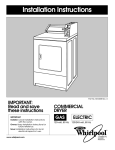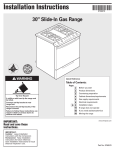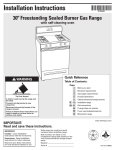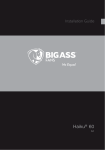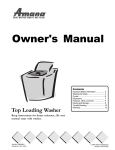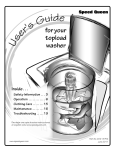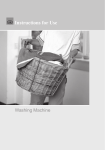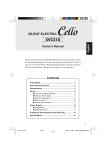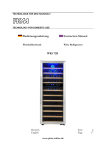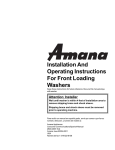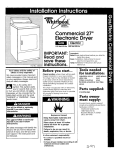Download Whirlpool 8316557 Clothes Dryer User Manual
Transcript
Installation Instructions Part No. 8316557 IMPORTANT: Read and save these instructions IMPORTANT Installer: Leave Installation Instructions with the owner. Owner: Keep Installation Instructions for future reference. Save Installation Instructions for local electrical inspector’s use. www.whirlpool.com COMMERCIAL ELECTRONIC DRYER GAS ELECTRIC 120-volt, 60 Hz 120/240-volt, 60 Hz ® COMMERCIAL LAUNDRY PRODUCTS Before you start... IMPORTANT SAFETY INSTRUCTIONS Your safety and the safety of others are very important. We have provided many important safety message in this manual and on your appliance. Always read and obey all safety messages. This is the safety alert symbol. This symbol alerts you to potential hazards that can kill or hurt you and others. All safety messages will follow the safety alert symbol and either the word “DANGER” or “WARNING”. These words mean: DANGER You can be killed or seriously injured if you don’t immediately follow instructions. WARNING You can be killed or seriously injured if you don’t follow instructions. All safety messages will tell you what the potential hazard is, tell you how to reduce the chance of injury, and tell you what can happen if the instructions are not followed. • Do not touch any electrical switch; do not use any phone in your building. • Clear the room, building or area of all occupants. • Immediately call your gas supplier — Do not store or use gasoline, from a neighbor’s phone. Follow or other flammable vapors and liquids the gas supplier’s instructions. in the vicinity of this or any other • If you cannot reach your gas appliance. supplier, call the fire department. — Installation and service must be — WHAT TO DO IF YOU SMELL GAS: done by a qualified installer, • Do not try to light any appliance. service agency or the gas supplier. WARNING: For your safety the information in this manual must be followed to minimize the risk of fire or explosion or to prevent property damage, personal injury or death. WARNING Explosion Hazard Keep flammable materials and vapors, such as gasoline, away from dryer. Place dryer at least 18 inches (45.8 cm) above the floor for a garage installation. Failure to do so can result in death, explosion, or fire. If installing a GAS dryer: Post this warning in a prominent location. It is recommended that the operator post, in a prominent location, instructions for the customer's use in the event the customer smells gas. This information should be obtained from your local gas supplier. Page 2 It is your responsibility to: Observe all governing codes and ordinances. Check code requirements: Some codes limit or do not permit installation of clothes dryers in garages, closets, mobile homes or sleeping quarters. Contact your local building inspector. Comply with the installation specifications and dimensions. Consider spacing requirements for companion appliances. Make sure you have everything necessary for proper installation. Properly install dryer. Contact a qualified installer to insure that the electrical and gas installations meet all national and local codes and ordinances. Exhaust to outdoors: Dryer must be exhausted outdoors to prevent exposure to harmful substances in the gas fuels. Note: The dryer must not be installed in an area where it will be exposed to water and/or weather, WARNING — To reduce the risk of fire, electric shock, or injury to persons when using your appliance, follow basic precautions, including the following: 1. Read all instructions before using the appliance. 2. Do not dry articles that have been previously cleaned in, washed in, soaked in, or spotted with gasoline, dry-cleaning solvents, or other flammable or explosive substances, as they give off vapours that could ignite or explode. 3. Do not allow children to play on or in the appliance. Close supervision of children is necessary when the appliance is used near children. 4. Before the appliance is removed from service or discarded, remove the door to the drying compartment. 5. Do not reach into the appliance if the drum is moving. 6. Do not install or store this appliance where it will be exposed to the weather. 7. Do not tamper with controls. 8. Do not repair or replace any part of the appliance or attempt any servicing unless specifically recommended in the usermaintenance instructions or in published user-repair instructions that you understand and have the skills to carry out. 9. Do not use fabric softeners or products to eliminate static unless recommended by the manufacturer of the fabric softener or product. 10. Do not use heat to dry articles containing foam rubber or similarly textured rubber-like materials. 11. Clean lint screen before or after each load. 12. Keep area around the exhaust opening and adjacent surrounding areas free from the accumulation of lint, dust, and dirt. 13. The interior of the appliance and exhaust duct should be cleaned periodically by qualified service personnel. 14. Do not place items exposed to cooking oils in your dryer. Items contaminated with cooking oils may contribute to a chemical reaction that could cause a load to catch fire. SAVE THESE INSTRUCTIONS Post this warning in a prominent location. FOR YOUR SAFETY Do not store or use gasoline or other flammable vapors and liquids in the vicinity of this or any other appliances. Exhaust requirements WARNING Fire Hazard Use a heavy metal vent. Do not use a plastic vent. Do not use a metal foil vent. Failure to do so can result in death or fire. Do not use non-metal flexible vent, metal vent that is smaller than four inches in diameter or exhaust hoods with magnetic latches. The dryer must be exhausted outdoors. Do not exhaust dryer into a gas vent, chimney, wall, ceiling, or concealed space of a building. Do not install flexible vent in enclosed walls, ceilings or floors. If using an existing exhaust system, clean lint from entire length of exhaust system. Make sure exhaust hood is not plugged with lint. The exhaust system should be inspected and cleaned yearly. Replace any plastic or metal foil exhaust vent with rigid metal or flexible metal vent. Use 4" (10.2 cm) vent clamps to secure vent system. Metal flexible vent must be fully extended and supported when the dryer is in its final position. DO NOT KINK OR CRUSH THE VENT. The metal flexible vent must be completely open to allow adequate exhaust air to flow. Allow as much room as possible when using elbows or making turns. Bend vent gradually to avoid kinking. Remove excess flexible vent to avoid sagging and kinking that may result in reduced air flow. Exhaust outlet is located at the center of the bottom dryer back. The exhaust vent can be routed up, down, left, right, behind the dryer or straight out the back of the dryer. Maximum length of exhaust system depends upon the type of vent used, number of elbows and type of exhaust hood. The maximum length for both rigid and flexible vent is shown in the chart. EXHAUST HOOD TYPE 4" (10.2 cm) good exhaust airflow 4" (10.2 cm) No. of 90° turns 4" (10.2 cm) 4" (10.2 cm) 4" (10.2 cm) 2-1/2" (6.4 cm) MAXIMUM LENGTH OF 4-INCH (10.2 cm) DIAMETER RIGID METAL VENT 0 1 2 3 4 exhaust airflow better exhaust airflow For exhaust systems not covered by the exhaust length chart, see Whirlpool Service Manual, “Exhausting Whirlpool Dryers,” Part No. 603197, available from your Whirlpool parts distributor. If dryer is installed in a confined area, such as a bedroom, bathroom or closet, it must be exhausted to the outside and provision made for enough air for combustion and ventilation. (Check governing codes and ordinances.) See “Recessed area and closet installation instructions” on Page 12. 64 FT. (19.5 m) 54 FT. (16.5 m) 44 FT. (13.4 m) 35 FT. (10.7 m) 27 FT. (8.2 m) 64 FT. (19.5 m) 54 FT. (16.5 m) 44 FT. (13.4 m) 35 FT. (10.7 m) 27 FT. (8.2 m) 58 FT. (17.7 m) 48 FT. (14.6 m) 38 FT. (11.6 m) 29 FT. (8.8 m) 21 FT. (6.4 m) MAXIMUM LENGTH OF 4-INCH (10.2 cm) DIAMETER FLEXIBLE METAL VENT 0 1 2 3 4 36 FT. (11.0 m) 31 FT. (9.4 m) 27 FT. (8.2 m) 25 FT. (7.6 m) 23 FT. (7.0 m) 36 FT. (11.0 m) 31 FT. (9.4 m) 27 FT. (8.2 m) 25 FT. (7.6 m) 23 FT. (7.0 m) 28 FT. (8.5 m) 23 FT. (7.0 m) 19 FT. (5.8 m) 17 FT. (5.2 m) 15 FT. (4.6 m) Four-inch metal exhaust vent is required. Plan installation to use the fewest number of elbows and turns. Page 3 Four-inch outlet hood is preferred. However, a 2-1/2-inch (6.4 cm) outlet exhaust hood may be used. A 2-1/2-inch (6.4 cm) outlet creates greater back pressure than other hood types. For permanent installation, a stationary exhaust system is required. A main exhaust vent can be used for exhausting a group of dryers. Main exhaust vent should be sized to remove 200 CFM of air per dryer. Large-capacity lint screens of proper design may be used in the main exhaust vent if checked and cleaned frequently. The room where the dryers are located should have make-up air equal to or greater than the CFM of all the dryers in the room. t en tv us a xh re ye dr air flow 30° max. dry er ex ha us tv en t 30° max. r ye dr nt ve st au h ex main collector vent dry 30° max. er ex ha us tv en t Back-draft Damper Kits, Part No. 3391910, are available from your Whirlpool dealer and should be installed in each dryer's exhaust vent to prevent exhausted air from returning into the dryers and to keep the exhaust in balance within the main exhaust vent. Unobstructed air openings are required. Each exhaust vent should enter the main vent at an angle pointing in the direction of the airflow. Vents entering from the opposite side should be staggered to reduce the exhausted air from interfering with the other vents. The maximum angle of each vent entering the main vent should be no more than 30°. Keep air openings free of dry cleaning fluid fumes. Fumes create acids which, when drawn through the dryer heating units, can damage dryers and loads being dried. A clean-out cover should be located on the main exhaust vent for periodically cleaning of the exhaust system. Page 4 An exhaust hood should cap the outside end of the main vent to prevent exhausted air from returning to the dryers. If an exhaust hood cannot be used, the outside end of the main vent should have a sweep elbow directed downward. If the main vent travels vertically through the roof, rather than through the wall, install 180° sweep elbow on the end of vent at least 2 feet (61 cm) above the highest part of the building. The opening wall or roof shall have a diameter 1/2 inch (1.3 cm) larger than the exhaust vent diameter. The exhaust vent should be centered in the opening. exhaust hood or sweep elbow wall horizontal vent main exhaust vent wall 180° sweep elbow 2 ft. (61 cm) min. above highest point of building vertical vent An exhaust hood should cap the exhaust vent to prevent exhausted air from returning into the dryer. The outlet of the hood must be at least 12 inches (30.5 cm) from the ground or anything else that may be in the path of the exhaust. main collector vent roof Do Not install screening or cap over end of vent. Gas Dryer Gas requirements WARNING Explosion Hazard Use a new AGA or CSA approved gas supply line. Install a shut-off valve. Securely tighten all gas connections. If connected to LP, have a qualified person make sure gas pressure does not exceed 13" (33 cm) water column. Examples of a qualified person include licensed heating personnel, authorized gas company personnel, and authorized service personnel. Failure to do so can result in death, explosion, or fire. OBSERVE ALL GOVERNING CODES AND ORDINANCES. A. The installation must conform with local codes, or in the absence of local codes with the National Fuel Gas Code, ANSI Z223.1/NFPA 54 installation codes. B. The design of this dryer has been certified by the CSA International for use at altitudes up to 10,000 feet (3048 m) above sea level at the B.T.U. rating indicated on the model/serial plate. Burner input adjustments are not required when the dryer is operated up to this elevation. When installed above 10,000 feet (3048 m), a four percent (4%) reduction of the burner B.T.U. rating shown on the model/serial plate is required for each 1,000 foot (305 m) increase in elevation. For assistance when converting to other gas types and/or installing above 10,000 feet (3048 m) elevation, contact your local service company. C. Check that dryer is equipped with the correct burner for the H. If local codes and ordinances permit, it is recommended that new particular type of gas used. Burner information can be found on the serial/rating plate in the door well of the appliance. If this information does not agree with the type of gas available, see your dealer. flexible metal tubing, design-certified by the AGA or CSA, be used for connecting the dryer to the gas supply line. (The gas feed pipe which extends through the lower rear of the dryer is provided with 3/8-inch metal pipe thread.) D. This dryer is equipped for use with NATURAL GAS. It is certified by CSA International for manufactured, mixed and L.P. (propane and butane) gases with appropriate conversion. No attempt shall be made to convert the appliance from the gas specified on the serial/rating plate for use with a different gas without consulting the serving gas supplier. Conversion must be done by a qualified service technician. Gas conversion kit part numbers are listed on the gas valve burner base. E. Provide a rigid gas supply line of 1/2-inch IPS pipe to the dryer location. If the total length of the supply line is more than 20 feet (6.1 m), larger pipe will be needed. For L.P. gas usage, 3/8-inch, approved copper tubing may be used. Pipe-joint compounds suitable for use with L.P. gas should be used. shutoff valve “open” position to dryer gas supply line F. The supply line shall be equipped with a shutoff valve installed within 6 ft. (1.8 m) of dryer in accordance with the National Fuel Gas Code, ANSI Z223.1 — latest edition*. This valve should be located in the same room as the dryer and should be in a location that allows ease of opening and closing. Do Not block access to the shutoff valve. G. If the dryer is installed in a confined area such as a bathroom or closet, provision must be made for enough air for combustion and ventilation. (Check governing codes and ordinances. or refer to the section of this instruction covering recessed and closet installations.) I. If rigid pipe is used as a gas supply line, a combination of pipe fittings must be used to obtain an in-line connection to the dryer. J. Make sure that lower edges of the cabinet, plus the back and bottom sides of the dryer are free of obstructions to permit adequate clearance of air openings for combustion air. See "Recessed area and closet installation instructions," page 12, for minimum spacing requirements. K. For ease of installation, operation and servicing (if ever needed) adequate space should be provided around the dryer. L. A 1/8-inch NPT plugged tapping, accessible for gauge testing, must be installed immediately upstream of the gas supply connection to the dryer. The dryer must be disconnected from the gas supply piping system during any pressure testing of the system at test pressures in excess of 1/2 psig. The dryer must be isolated from the gas supply piping system by closing the equipment shut-off valve during any pressure testing of the gas supply piping system at test pressures equal to or less than 1/2 psi. Electrical requirements WARNING Electrical Shock Hazard Plug into a grounded 3-prong outlet. Do not remove ground prong. Do not use an adapter. Do not use an extension cord. Failure to follow these instructions can result in death, fire, or electrical shock. Important: Observe all governing codes and ordinances. A 120-volt, 60-Hz, AC-only, 15- or 20-ampere fused electrical supply is required. A time-delay fuse or circuit breaker is recommended. It is recommended that a separate circuit serving only this appliance be provided. If codes permit and a separate ground wire is used, it is recommended that a qualified electrician determine that the ground path is adequate. Recommended ground method The dryer, when installed, must be electrically grounded in accordance with local codes, or in the absence of local codes, with the National Electrical Code, ANSI/NFPA 70*. GROUNDING INSTRUCTIONS: This appliance must be grounded. In the event of malfunction or breakdown, grounding will reduce the risk of electric shock by providing a path of least resistance for electric current. The power supply cord plug must be plugged into an appropriate outlet that is properly installed and grounded in accordance with all local codes and ordinances. WARNING - Improper connection of the equipment-grounding conductor can result in a risk of electric shock. Check with a qualified electrician or serviceman if you are in doubt as to whether the appliance is properly grounded. Do not modify the plug provided with the appliance - if it will not fit the outlet, have a proper outlet installed by a qualified electrician. 3-prong ground-type outlet 3-prong ground plug power supply cord ground prong Copies of the standards listed above may be obtained from: * National Fire Protection Association One Batterymarch Park Quincy, Massachusetts 02269 Page 5 Now Start... With dryer in laundry area. WARNING Excessive Weight Hazard Use two or more people to move and install dryer. Failure to do so can result in back or other injury. 5. Move dryer close to final position. Remove cardboard or 10. To exhaust dryer, see Exhaust requirements, Pages 3-4. Connect hardboard from under dryer. exhaust vent system to dryer exhaust outlet and exhaust hood using 4" (10.2 cm) clamps. Use caulking to seal exterior wall opening around exhaust hood. 6. Remove red cap from gas pipe. Carefully move dryer into final position. Place level on top of the dryer, first side to side; then front to back. If the dryer is not level, adjust the legs of the dryer up or down until the dryer is level. 7. Connect gas supply to dryer. Use pipe-joint compound resistant to 3-prong, ground-type outlet exhaust duct gas supply line the action of L.P. gas for gas connections. If flexible metal tubing is used, be certain there are no kinks. If necessary for service, open the toe panel, use a putty knife to press on the toe panel lock located at the center top of the toe panel. Pull downward on the toe panel to open. Toe panel is hinged at the bottom. 8. Open the shutoff valve in the gas supply line. gas shutoff valve 1. Take tape off front corners of dryer. Open dryer and remove the literature and parts packages. Wipe the interior of the drum thoroughly with a damp cloth. 2. Take two of the cardboard corners from the carton and place them on the floor in back of the dryer. Firmly grasp the body of the dryer and gently lay it on its back on the cardboard corners. 3. With one of the legs in hand, check the ridges for a diamond marking. That's how far the leg is supposed to go into the hole. 4. Start to screw the leveling legs into the holes by hand. (Use a small amount of liquid detergent to lubricate the screw threads so it is easier to turn the legs.) Use a 1-inch wrench or socket wrench to finish turning the legs until you reach the diamond mark. Now stand the dryer up. Slide dryer onto cardboard or hardboard before moving across floor to avoid damaging floor covering. Page 6 9. Use a non-corrosive leak detection fluid to check for leaks. Bubbles around connections will indicate a leak. NEVER TEST FOR GAS LEAKS WITH A FLAME. If a leak appears, shut off gas valve controls and adjust connections. Then check connections again. Close toe panel. All connections must be wrenchtightened. 11. Carefully move dryer into final position. Place level on top of the dryer, first side to side; then front to back. If the dryer is not level, adjust the legs of the dryer up or down until the dryer is level. 12. Plug power supply cord into grounded outlet. 13. Check dryer operation (some accumulated time may be on the timer due to factory testing). Pull timer-set button left. (Operating time will accumulate per number of depressions and type of timing cam used.) Push START/RESTART button. Using a full heat cycle (not the air cycle), let the dryer run for at least five minutes. Note: Dryer door must be closed for dryer to operate. When door is open, dryer stops, but timer continues to run. To restart dryer, close door and push START/RESTART button. 14. If the burner does not ignite and you can feel no heat inside the dryer, shut off dryer for five minutes. Check that all supply valve controls are in "ON" position and that the electrical cord is plugged in. Repeat five-minute test. 15. If drying time is too long, make sure lint screen is clean. Electric Dryer Electrical requirements If codes permit and a separate ground wire is used, it is recommended that a qualified electrician determine that the ground path is adequate. Important: Observe all governing codes and ordinances. A four-wire or three-wire, singlephase, 120/240-volt, 60-Hz, AC-only electrical supply (or four-wire or threewire, 120/208-volt, if specified on the model/serial rating plate) is required on a separate, 30-ampere circuit, fused on both sides of the line. A timedelay fuse or circuit breaker is recommended. Now Start... WARNING Excessive Weight Hazard Use two or more people to move and install dryer. Failure to do so can result in back or other injury. With dryer in laundry area... fuse disconnect box exhaust vent system 30-amp outlet Recommended ground method It is the personal responsibility and obligation of the customer to contact a qualified electrician to assure that the electrical installation is adequate and in conformance with the National Electrical Code, ANSI/NFPA 70 — latest edition*, and all local codes and ordinances. Copies of the standards listed above may be obtained from: * National Fire Protection Association One Batterymarch Park Quincy, Massachusetts 02269 1. Take tape off front corners of dryer. Open dryer and remove the literature and parts packages. Wipe the interior of the drum thoroughly with a damp cloth. 2. Take two of the cardboard corners from the carton and place them on the floor in back of the dryer. Firmly grasp the body of the dryer and gently lay it on its back on the cardboard corners. 3. With one of the legs in hand, check the ridges for a diamond marking. That's how far the leg is supposed to go into the hole. 4. Start to screw the leveling legs into the holes by hand. (Use a small amount of liquid detergent to lubricate the screw threads so it is easier to turn the legs.) Use a 1-inch wrench or socket wrench to finish turning the legs until you reach the diamond mark. Now stand the dryer up. Slide dryer onto cardboard or hardboard before moving across floor to avoid damaging floor covering. 5. Move dryer close to final position. Remove cardboard or hardboard from under dryer. Page 7 6. Make electrical connection. This dryer is manufactured with the cabinet-ground conductor connected to the NEUTRAL (center) of the wiring harness at the terminal block. If local codes do NOT permit this type of connection, use “Fourwire connection” instructions. For a grounded, cord-connected appliance — GROUNDING INSTRUCTIONS: This appliance must be grounded. In the event of malfunction or breakdown, grounding will reduce the risk of electric shock by providing a path of least resistance for electric current. If using a power supply cord, the plug must be plugged into an appropriate outlet that is properly installed and grounded in accordance with all local codes and ordinances. WARNING - Improper connection of the equipment-grounding conductor can result in a risk of electric shock. Check with a qualified electrician or serviceman if you are in doubt as to whether the appliance is properly grounded. Do not modify the plug provided with the appliance - if it will not fit the outlet, have a proper outlet installed by a qualified electrician. For a permanently connected appliance — GROUNDING INSTRUCTIONS: This appliance must be connected to a grounded metal, permanent wiring system; or an equipment-grounding conductor must be run with the circuit conductors and connected to the equipment-grounding terminal or lead on the appliance. Power supply cord Use a new UL-approved power supply cord rated 240-volt min., 30 amperes and marked for use with a clothes dryer. Direct wire WARNING WARNING Fire Hazard Use a new UL approved 30 ampere power supply cord. Use a UL approved strain relief. Disconnect power before making electrical connections. Connect neutral wire (white or center wire) to center terminal (silver). Ground wire (green or bare wire) must be connected to green ground connector. Connect remaining 2 supply wires to remaining 2 terminals (gold). Securely tighten all electrical connections. Failure to do so can result in death, fire, or electrical shock. 1. Disconnect the power supply. external ground conductor screw tab terminal block cover holddown screw 2. Remove hold-down screw and terminal block cover. Fire Hazard Use 10 gauge solid copper wire. Use a UL approved strain relief. Disconnect power before making electrical connections. Connect neutral wire (white or center wire) to center terminal (silver). Ground wire (green or bare wire) must be connected to green ground connector. Connect remaining 2 supply wires to remaining 2 terminals (gold). Securely tighten all electrical connections. Failure to do so can result in death, fire, or electrical shock. strain relief clamp sections 3. Assemble dryer cabinet strain relief screws 3/4" U.L.-listed strain relief (U.L. marking on strain relief) into the hole below terminal block opening. Tighten strain relief screws just enough to hold the two clamp sections together. Install power supply cord/cable through the strain relief. Complete installation following instructions for your type of connection: • Four-wire (recommended method) • Three-wire (if four-wire is not available) Page 8 Four-wire connection... Four-wire receptacle (required for mobile homes) POWER SUPPLY CORD 5. Remove appliance ground wire (green with yellow stripes) from external ground connector screw. Fasten under center, silver-colored terminal block screw. spade terminals with upturned ends NEUTRAL 3/4" U.L.-listed strain relief ground prong NEUTRAL (white) ground wire (green) Four-wire power supply cord must have four, No.-10 copper wires and match a four-wire receptacle of NEMA Type 14-30R. The fourth wire (ground conductor) must be identified with a green cover and the neutral conductor by a white cover. DIRECT WIRE 8. Connect the other wires to outer terminal block screws. Tighten screws. 9. Tighten strain relief screws. 10. Insert tab of terminal block cover into slot of the dryer rear panel. Secure cover with hold-down screw. 4. Remove center terminal block screw. Preparing the wire: 3-1/2" (8.9 cm) to disconnect box 6. Connect ground wire (green) of power supply cord to external ground conductor screw. Tighten screw. 7. Connect neutral wire (white or center) of power supply cord under center screw of the terminal block. Tighten screw. ring terminals 3/4" U.L.listed strain relief 4. Remove center terminal block screw. 1" (2.5 cm) of wires stripped of insulation NEUTRAL wire (white or center) bare ground wire 10-gauge, 3-wire with ground wire (Romex) 5" (12.7 cm) Strip 5" (12.7 cm) of outer covering from end of cable. Leave bare ground wire at 5 inches. Cut 1-1/2" (3.8 cm) from 3 remaining wires. Strip insulation back 1 inch (2.5 cm). Shape ends of wires into a hook. 5. Remove appliance ground wire (green with yellow stripes) from external ground connector screw. Fasten under center, silver-colored terminal block screw. 6. Connect the ground wire (bare) of the power supply cable to the external ground conductor screw. Tighten screw. 7. Place the hooked end of the neutral wire (white or center) of power supply cable under the center screw of terminal block (hook facing right). Squeeze hook end together. Tighten screw. 8. Place the hooked ends of the other power supply cable wires under the outer terminal block screws (hook facing right). Squeeze hooked ends together. Tighten screws. 9. Tighten strain relief screws. 10. Insert tab of terminal block cover into slot of dryer rear panel. Secure cover with hold-down screw. Page 9 Three-wire connection... Three-wire receptacle POWER SUPPLY CORD Where local codes permit connecting cabinet-ground conductor to neutral wire: 4. Loosen or remove center spade terminals with upturned ends terminal block screw. 5. Connect the neutral wire (white ring terminals This blade connected to this conductor. or center) of power supply cord to the center, silver-colored terminal screw of the terminal block. Tighten screw. 6. Connect the other wires to outer terminal block screws. Tighten screws. NEUTRAL 3/4" U.L.-listed strain relief NEUTRAL (white or center) Three-wire power supply cord must have three, No.-10 copper wires and match a three-wire receptacle of NEMA Type 10-30R. 7. Tighten strain relief screws. 8. Insert tab of terminal block cover into slot of dryer rear panel. Secure cover with hold-down screw. DIRECT WIRE Where local codes permit Preparing the wire: 4. Loosen or remove center terminal block screw. connecting cabinet-ground conductor to neutral wire: Three-wire with ground wire: Bare wire cut short. Wire is not used. Dryer is grounded through direct wire cable. 3/4" (1.9 cm) 1" 2.5 cm) U.L.-listed strain of wires stripped of to insulation disconnect box 10-gauge, 3-wire or, 10-gauge, 3-wire with ground wire (Romex) NEUTRAL wire (white or center) Strip 3-1/2" (8.9 cm) of outer covering from end of cable. Strip insulation back 1" (2.5 cm). If using 3-wire cable with ground wire, cut bare wire even with outer covering. Page 10 3-1/2" (8.9 cm) 5. Place the hooked end of the neutral wire (white or center) of power supply cable under the center screw of the terminal block (hook facing right). Squeeze hooked end together. Tighten screw. 6. Place the hooked ends of the other power supply cable wires under the outer terminal block screws (hook facing right). Squeeze hooked ends together. Tighten screws. 7. Tighten strain relief screws. 8. Insert tab of terminal block cover Shape ends of wires into a hook. into slot of dryer rear panel. Secure cover with hold-down screw. Three-wire connection... Three-wire receptacle DIRECT WIRE OR POWER SUPPLY CORD Where local codes Do Not permit connecting cabinet-ground conductor to neutral wire: 9. After reattaching the terminal Three-wire power supply cord must have three, No.-10 copper wires and match a three-wire receptacle of NEMA Type 10-30R. Direct wire power supply cable must be prepared as shown in “Preparing the wire” of the three-wire connection direct-wire steps above. If codes permit and a separate ground wire is used, it is recommended that a qualified electrician determine that the ground path is adequate. 4. Remove center terminal block screw. cover, connect a separate copper ground wire from the external ground connector screw to an adequate ground. 5. Remove the appliance harness ground wire (green with yellow stripes) from the external ground connector screw. Connect appliance harness ground wire and the neutral wire (white or center) of the power supply cord/cable under the center, silver-colored terminal block screw. Tighten screw. 6. Connect the other wires to outer terminal block screws. Tighten screws. 7. Tighten strain relief screws. 8. Insert tab of terminal block cover into slot of dryer rear panel. Secure cover with hold-down screw. 7. To exhaust dryer, see Exhaust requirements, Pages 3-4. Connect 10. Check dryer operation (some accumulated time may be on the exhaust vent to dryer exhaust outlet and exhaust hood using 4" (10.2 cm) clamps. Use caulking to seal exterior wall opening around exhaust hood. timer due to factory testing). 8. Carefully move dryer into final position. Place level on top of the dryer, first side to side; then front to back. If the dryer is not level, adjust the legs of the dryer up or down until the dryer is level. 9. Plug power supply cord into grounded outlet or connect direct Pull timer-set button left. (Operating time will accumulate per number of depressions and type of timing cam used.) Push START/RESTART button. Using a full heat cycle (not the air cycle), let the dryer run for at least five minutes. 11. If drying time is too long, make sure lint screen is clean. 12. Now start the dryer and allow it to complete a full heat cycle (not air cycle) to make sure it is working properly. Note: Dryer door must be closed for dryer to operate. When door is open, dryer stops, but timer continues to run. To restart dryer, close door and push START/RESTART button. wire to power supply. Turn power supply on. Page 11 Recessed area and closet installation instructions Product dimensions 29" (73.7 cm) This dryer may be installed in a recessed area or closet. For recessed area and closet installations, minimum clearances can be found on the serial tag on the dryer. The installation spacing is in inches and is minimum allowable. Additional spacing should be considered for ease of installation, servicing and compliance with local codes and ordinances. If closet door is installed, the minimum unobstructed air openings in top and bottom is required. Louvered doors with equivalent air openings are acceptable. Companion appliance spacing should be considered. The dryer must be exhausted outdoors. No other fuel-burning appliance may be installed in the same closet. 16" (40.6 cm) ELECTRIC 14-19/32" (37.1 cm) 4-3/4" (12.1 cm) EXHAUST 4" (10.2 cm) dia. 28-1/4" (71.8 cm) 18-3/8" (46.7 cm) 1-1/4" (3.2 cm) 25-1/2" (64.8 cm) If dryer does not operate properly... 7-1/8" (18.1 cm) 35" (88.9 cm) 0" (0 cm)* 0" (0 cm)* 1" (2.5 cm) Recessed front view Closet side view Closet door • Clean lint screen after each cycle. • Keep dryer area clear and free from combustible materials, gasoline and other flammable vapors and liquids. • Do not obstruct the flow of combustion and ventilation air. Moving the dryer to a new location... 3" (7.6 cm) 48" sq.** Slide dryer onto cardboard or hardboard before moving across floor to avoid damaging floor covering. 24" sq.** 3" (7.6 cm) Closet front view * Additional clearances for wall, door and floor moldings may be required or if external exhaust elbow is used. ** Opening is minimum for closet door. Louvered door with equivalent air opening is acceptable. Part No. 8316557 © 2000 Whirlpool Corporation SIDE VIEW Maintenance instructions 0" (0 cm)* Before the appliance is removed from service or discarded, remove the door to the dryer compartment. BACK VIEW 1" (2.5 cm) Closet door 15" (3.8 cm)** All models: • Make sure leveling legs are secure in dryer base. • Tape drum to front panel. • Tape dryer door, lint screen and end of gas pipe. GAS Minimum Installation Clearances 14" (35.6 cm) max. Electric dryer models: • Shut of electrical supply to dryer. • Disconnect the power supply cord or cable from the dryer terminal block. Gas dryer models: • Disconnect electrical cord. Tape securely to dryer. • Shut off the gas supply valves in the gas supply line. • Disconnect gas pipe and fittings from dryer and cap gas supply line. Tape end of dryer gas pipe. Check the following to be sure that: 1. Electric supply is connected. 2. Circuit breakers are not tripped or house fuses blown. 3. Door is closed. 4. Controls are set in a running or “ON” position. 5. Start button has been pushed firmly. 6. For gas dryers, check that gas supply shutoff valves are set in open position. If you need assistance... The Whirlpool Consumer Interaction Center will answer any questions about operating or maintaining your dryer not covered in the Installation Instructions. The Whirlpool Consumer Interaction Center is open 24 hours a day, 7 days a week. Just dial 1-800 NO BELTS (1-800-662-3587) — the call is free. When you call, you will need the dryer model number and serial number. Both numbers can be found on the serial-rating plate located on your appliance. Prepared by Whirlpool Corporation, Benton Harbor, Michigan 49022 Printed in U.S.A.












